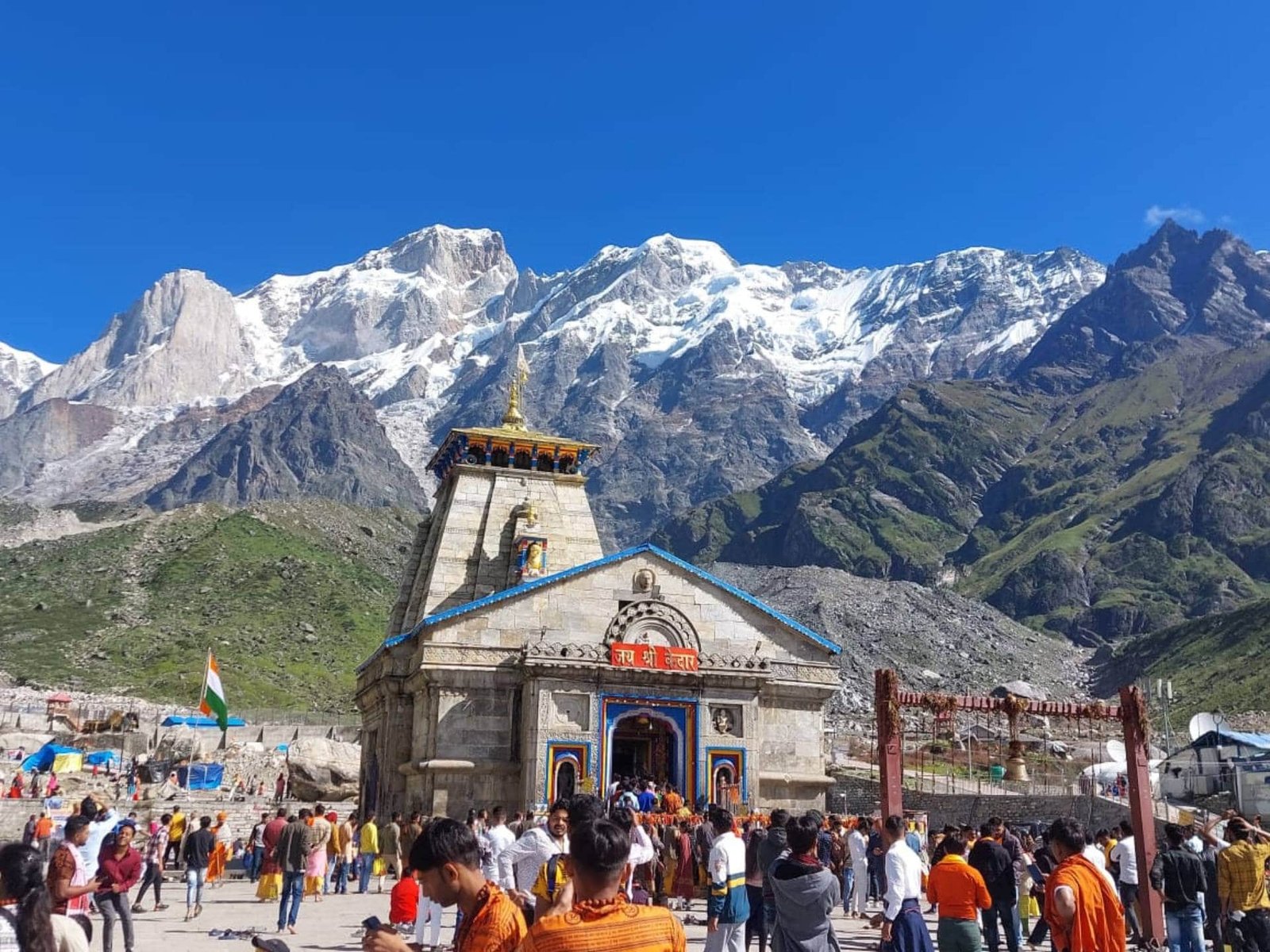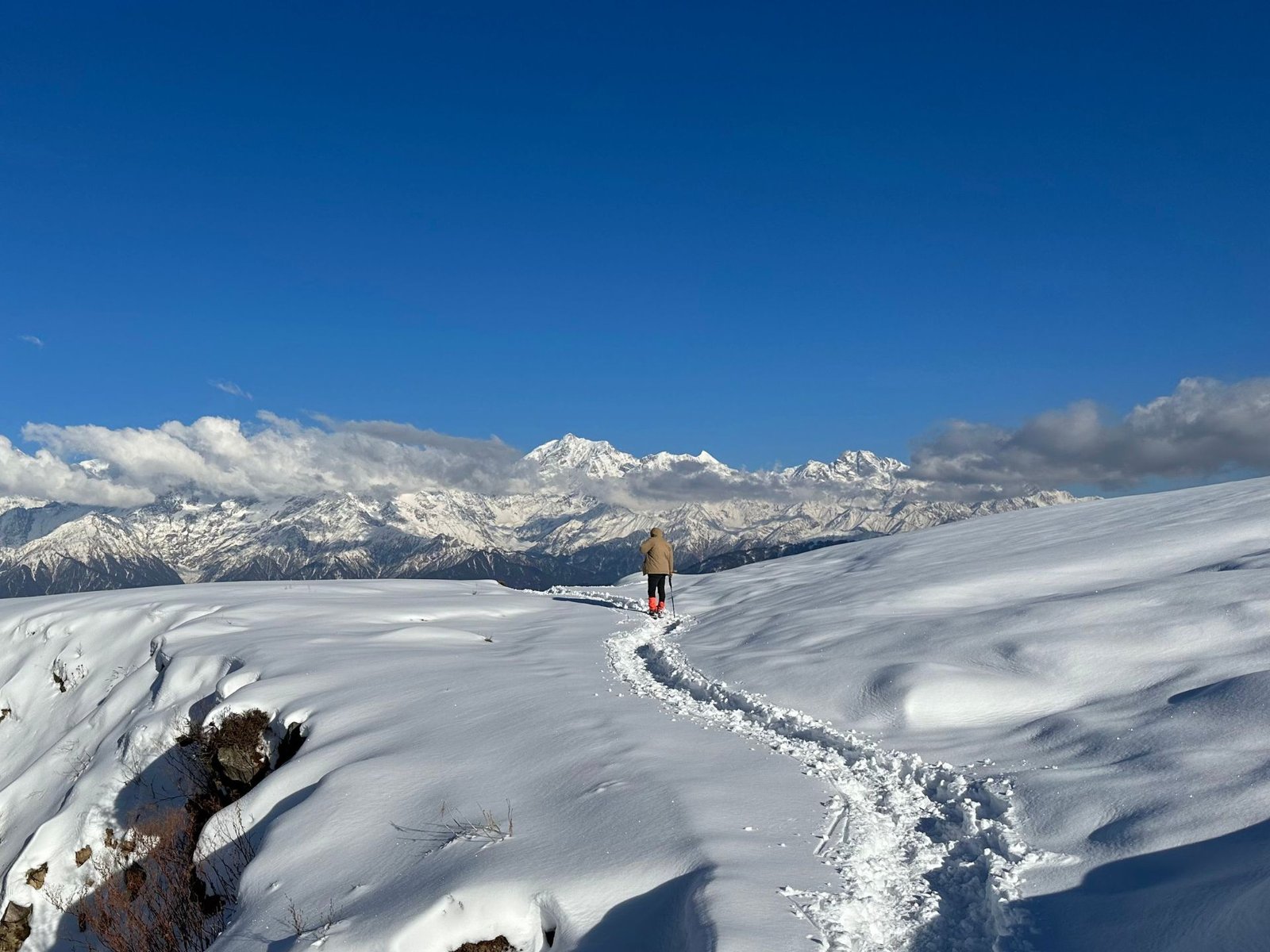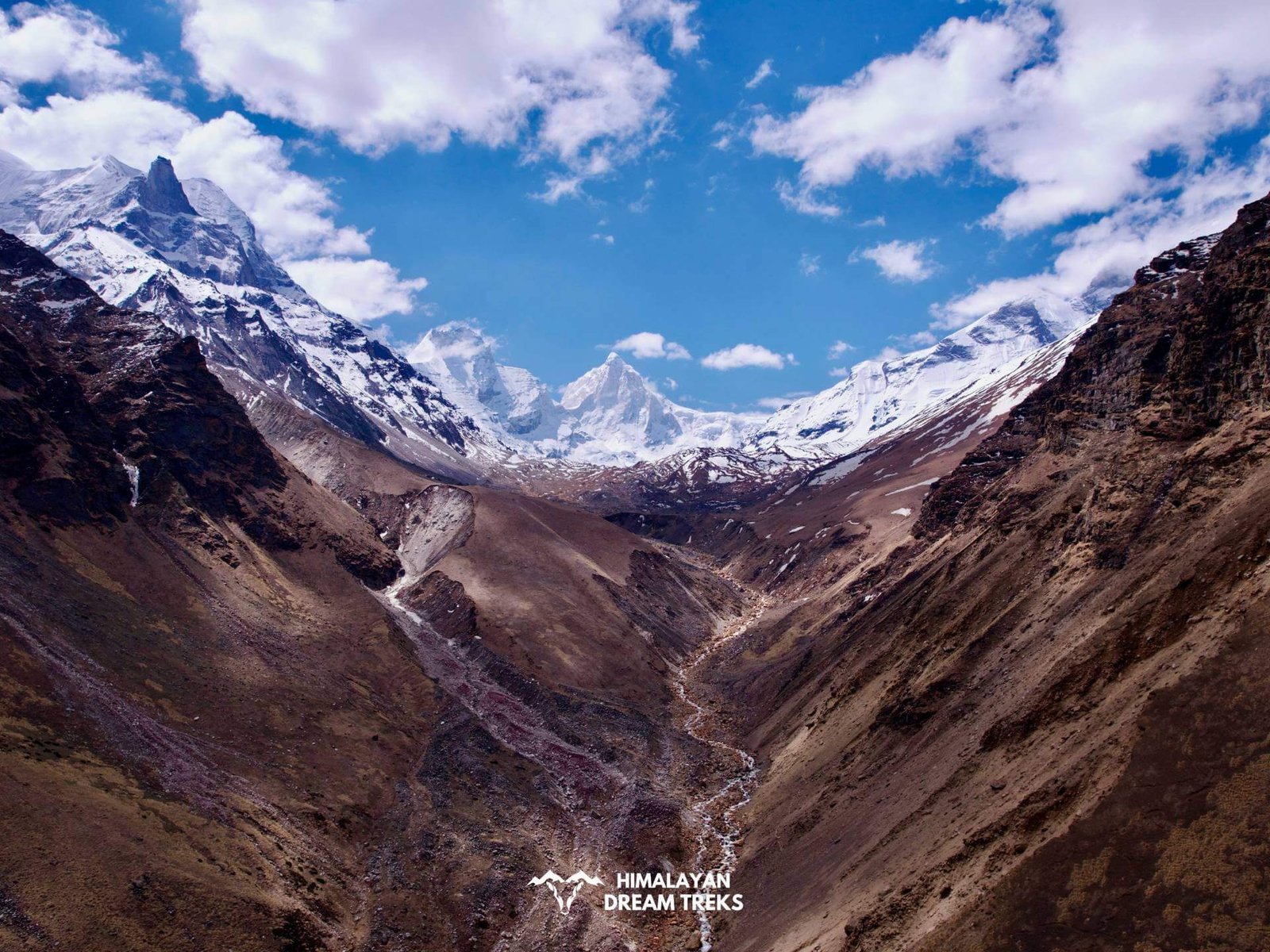Kedarnath Yatra 2025 | Complete Guide, Cost, Itinerary
Region: Uttarakhand
Base Camp: Gaurikund
Days: 4 Days
Altitude: 11,600 ft
Grade: Moderate
Distance: 32 Km
Min Age: 8 Years+
Best Season: Summer and Autumn
Trek Description
Kedarnath located in Rudraprayag district of Uttarakhand is one of the 12 Jyotirlingas and one of the important Panch Kedar. At Kedarnath, the Hump of Lord Shiva is worshipped and other parts of Lord Shiva are worshipped in the other Panch Kedars.
Kedarnath holds religious and historical significance dating back thousands of years. It’s believed that Adi Guru Shankaracharya rediscovered the Kedarnath temple after it was buried under snow for centuries.
The journey to Kedarnath starts from Rishikesh. A typical itinerary is 3 nights and 4 days long which takes you to places such as Rishikesh, Guptakashi, Gaurikund, and Kedarnath.
The Kedarnath Temple is scheduled to open on May 12, 2024, this year. The best time to do this trek is May, June, September, and October. Prior to your yatra, you will need to register yourself on the Char Dhaam portal.
The overall trek distance from Gaurikund to Kedarnath is around 16 km so the total distance is approximately 32 km. You may feel the trek distance to be more than 16 km. This is due to the altitude gain of 5,072 feet, requiring greater endurance.
Itinerary
Drive Distance: 185 km
Drive Time: 7-8 hours
Altitude: 4,530 ft
Our journey will start from Rishikesh early morning. The overall driving distance is 163 km and usually takes around 7-8 hours to complete, but it can take more time due to traffic in the peak season.
During our journey, we will follow along the river Ganga until Devprayag, then continue alongside the Alaknanda River, and finally drive alongside the Mandakini River in the last stretch.
Along the way, we will visit Dhari Devi Temple and the confluence points known as prayags, including Devprayag, Rudraprayag, Agastmuni, and Guptkashi.
Overnight stay will be in Guptkashi.
Trek Distance: 16 km
Trek Time: 7-8 hours
Altitude: 6,558 ft
Altitude Gain: 5,072 ft
Next morning drive from Guptkashi to Sonprayag. Driving distance is 30 km and will take 1-2 hours to complete. Once we reach Sonprayag, we will take a local taxi to Gaurikund, which is around 6 km away.
From Gaurikund the trek will start. The overall distance from Gaurikund to Kedarnath is around 16 km. Yatra path is well paved with stones and railing. Altitude gain is 5,072 feet which can lead to AMS (Acute Mountain Sickness). Make sure to ascend slowly, keep enough water with you and snacks.
Along the trail, you will walk with other pilgrims and sadhus. There will be constant movement of mules on the trail. Make sure to give them the side and keep your distance.
By evening we will reach Kedarnath. Check into your accommodation, rest a bit and get ready to join the evening Arti.
Trek Distance: 16 km
Trek Time: 5-6 hours
Wake up early in the morning and get in the line to have Darshan. During peak season it can take hours before you get a chance for Darshan. After darshan, explore places like Kaal Bhairav Temple, Mandakni Ghat, Bhim Shilla, and Adi Shankaracharya Statue.
Kedarnath Valley is surrounded by beautiful peaks, flora and fauna. Just behind Kedarnath, you will see Kedar Dome, Kedarnath Main, Chorabari Glacier, and Kedarnath Glacier. Near Kaal Bhairav Temple you will find meadows filled with wild flowers, particularly Bhringraj.
Soak in all the peace and spiritual aura of the valley. After your wonderful time, get ready to descend down. Make sure to keep enough water and snacks with you.
By evening we will be back to Gaurikund. Via local taxi, we will go to Sonprayag from Gaurikund and from there to Guptkashi. The night stay will be in Guptkashi.
Drive Distance: 185 km
Drive Time: 7-8 hours
Today, it’s time to return to Rishikesh. Our journey will take us back from the same route we came. By evening we will be back to Rishikesh and from there you can continue your journey and return home.
What’s Included?
Price Inclusion
- Transportation from Rishikesh and back
- Accommodation for 3 nights on a triple/quad-sharing basis (2 nights in a hotel + 1 night in a camp at Kedarnath)
- Trip Leader to guide the group
- 24/7 Medical Support throughout the trek
- Chardham Registration & Required Permits included
Price Exclusion
- Meals during transportation.
- 5% GST (not included in the package price)
- Any items not mentioned in the inclusions
- Any expenses arising from emergencies during the trek
- Personal expenses (mules, ponies, helicopters, or Kandi are not included)
Note: The price and dates mentioned are for group departures. If you wish to customize your yatra, we offer flexible dates and personalized itineraries at an additional cost.
Things to Carry
- 40-50 Ltr Bag Pack With Rain Cover & Comfortable Straps
- Hot & Cold Water Bottle Like Borosil & Milton
- Energy Bar, Dry Fruits & ORS
- Personal Medical Kit
- 2/3 Full Sleeves (Non-Cotton)
- 1 Full Fleece T-Shirt
- 1 Fleece Jacket (Woollen Or Sweater)
- 1 Down Feather/Hollofil Jacket
- 1 Waterproof Jacket/Poncho
- 1 Pair Thermal Inners (Upper And Lower)
- 2 Trek Pants (Avoid Shorts & Denim Pants)
- 1 Pair of Waterproof Gloves
- 1 Pair of Woollen Gloves
- Sun Cap
- Woollen Cap
- 4 Pairs Of Cotton Socks
- 1 Pair Of Woollen Socks
- 1 Pairs Of Sunglasses (U/V Protected)
- 1 Neck Gaiters (Buff)
- Tiffin Box
- 1 Waterproof & High Ankle Trekking Shoes
- 1 Pair Of Floaters
- Hand Sanitizer & Sunscreen Lotion
- Toothbrush And Toothpaste
- Quick Dry Towel
- Lip Balm & Antibacterial Powder
- Moisturizer
How To Reach Kedarnath
Flight is the quickest and easiest means to reach Rishikesh in Uttarakhand. Booking a flight to this destination is not a hard job, you can get a flight from most metro cities in India.
The nearest airport to Rishikesh is Jolly Grant Airport which is located approximately 25 kilometers from the city center. Several flight operators like Air India, Akasa Air, Vistara, and others operate flights to Jolly Grant Airport, which makes your transportation easy and comfortable.
It is recommended to book a flight at least a month before traveling since the last moment flight booking is comparatively higher than the standard price. If Dehardun flight charges are high then we recommend you take flights to Delhi. From there, you can take UTC, HRTC, buses, railway or hire a taxi to reach Rishikesh.
Rishikesh is one of the major cities in Uttarakhand and it is well-connected to other cities by train. So traveling here via train is another easiest way.
Your train transportation is served by the Yog Nagri Railway Station. You also can opt for Haridwar Railway Station and from there you can reach Rishikesh via bus or taxi.
A road trip is one of the most exciting journeys to reach Rishikesh and start the Dayara Bugyal Trek. It should not be any challenging matter since the city is connected with other major cities like Delhi, Chandigarh, and Jaipur by National Highways.
It might be time-consuming but bus travel is affordable compared to another mode of transport.
Kedarnath is well connected with the road to Sonprayag. During peak seasons you will find multiple private buses from Rishikesh, Haridwar, and Dehradun to Guptkashi or Sonprayag. Bus tickets range from INR 500-600. These are small buses and don’t have much leg space. Pack your bag in a way that you can sit comfortably.
Taxis are also available from Dehradun, Rishikesh, and Hardwar. The cost will depend on total number of seats sold.
Raithal is the point where we start our Dayara Bugyal Trek in Uttarakhand. It is approximately 183 kilometers away from Dehradun, which takes around 6 to 7 hours by public transportation. To reach Raithal you have to reach Uttarkashi first.
The bus to Uttarkashi leaves early in the morning around 5:30 am from Dehradun Hill station. You can also book your ticket online via the UTC portal. The average cost of the ticket is around 350 to 400 INR. Shared taxi option is also available.
If you are traveling via taxi, you will be charged around 400 to 500. You can hire a taxi from Rispana Pul and Parade Ground to Uttarkashi. Upon reaching Uttarkashi, you can rent another taxi to Raithal from Uttarkashi Taxi Stand. You must pay 100 to 150 INR to hire the taxi.
Difficulty Level of Kedarnath
Kedarnath Yatra is in the moderate category. Trek distance and altitude gain make it a bit difficult. The overall trek distance is 16 km from Gaurikund to Kedarnath with an altitude gain of 5,072 feet. Sudden altitude gain of this elevation poses a risk of AMS and Fatigue. Make sure you drink plenty of water, have enough snacks, and are in the best shape.
Physical fitness and endurance are much needed on this Yatra. Before planning your Yatra, train your body in the gym or via running and jogging.
It’s even better if you have done some high-altitude trek before.
Best Time to do Kedarnath
The best time for Kedarnath Yatra is in months of May, June, September, and October. During May and June, the weather is favorable with less rain and not-so-cold temperatures. But it’s also this time when you will find lot of crowd and rush.
If you prefer less crowded and peaceful times then the months of September and October are much suited. But also keep cold temperatures in mind in these months. If you are found with cold temperatures then you can consider Autumn months.
Off Season: Off season in Kedarnath is considered months of monsoon, i.e. End week of June to the First week of September. But these months are also dangerous due to heavy rain, landslides, cloud bursts, and flash floods.
More Info Regarding Kedarnath
After the events of the Mahabharata, Pandavas were in remorse. Their participation in the war led to the deaths of their kin, teachers, and countless others. Their sins hindered their path to Moksha.
Pandavas actions during the Mahabharata, including the use of deceitful tactics on the battlefield did not find favor with Lord Shiva, who is the protector of righteousness. Hence they were in pursuit of Lord Shiva to guide them and free them from their sins.
During their Yatra in the Himalayas, they reached a beautiful valley where they felt the presence of Shiva. Among the heard, Lord Shiva was in the form of a Bull. Bhim tried to approach the Bull but as soon as they touched, Lord Shiva disappeared into the earth.
Later parts of the Bull appeared in different parts of the Himalayas and became known as Panch Kedar.
Kedarnath Valley is blessed with natural resources. As soon as you start your trek you get to see hundreds of wildflowers, water springs, and natural beauty.
You will come across flowers like Himalayan Balsam, Brahma Kamal, Juniper, Cyananthus Lobatus, Anaphalis Margaritacea, and The Himalayan Bistort.
Kedarnath Valley and Kedarnath Wildlife Sanctuary is home to Black bear, Ibex, Monal, and Leopard. The constant movement of humans in and around the valley makes it hard for these animals to show themselves.
- Chopta
- Tungnath
- Ukimath
- Kalimath
- Vasuki Tal
- Triyuginarayan Temple
Gallery

Map of Trail
FAQs
Kedarnath temple was built by Jagad Guru Adi Shankaracharya.
Kedarnath temple is said to be more than 1,200 years old.
The two peaks visible from the Kedarnath valley are Kedar Peak and Kedar Dome.
The sacred river that flows through Kedarnath is Mandakini.
You can register online for the Kedarnath Yatra. It’s free, mandatory, and should be done in advance.
11,999
/ Per Person
Available Dates
Contact us for Booking
Contact us for Booking





Leave a Comment